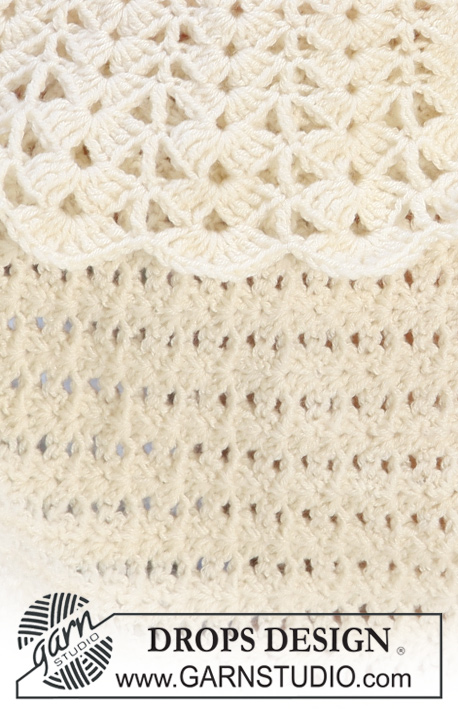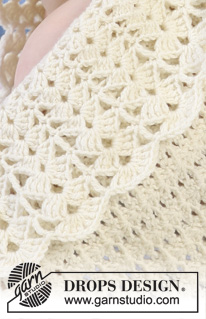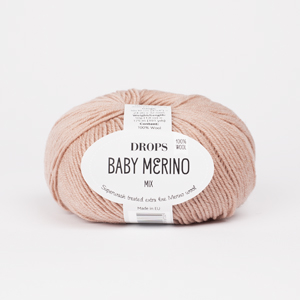Comments / Questions (52)
![]() Leila Kure wrote:
Leila Kure wrote:
Hvad angår huen, så står der i række 17 at man skal fortsætte indtil den måler 10 cm fra midt på hovedet. Er det lodret eller vandret? Fra spidsen og ned eller det bredden. Det er jo ret vigtigt.
14.03.2025 - 00:58DROPS Design answered:
Hei Leila. Når det skal måles fra midt oppå luen og til 17. omgang blir det loddrett. Bredden/omkretsen på luen måles ikke, men det oppgis helt øverst i oppskriften hvilken str. passer cm hodemål. mvh DROPS Design
17.03.2025 - 10:33
![]() Matilda wrote:
Matilda wrote:
Jag tycker att det ser ut som att det är fyra stolpar på varje sida av solfjädern på filten men i mönstret är blir det bara två (eftersom man delar två på varje sida om stolparna i nya varvet) jag förstår inte vilket som gäller?
23.02.2025 - 20:50DROPS Design answered:
Hei Mathilda. Usikker på hvor du mener du ser 4 stolpar på varje sida av solfjädern på teppet. Når rad 2 hekles, hekles det 4 stolper mellom de 2 midterste stolpene i hver st-gruppe raden under. mvh DROPS Design
03.03.2025 - 12:50
![]() Matilda wrote:
Matilda wrote:
Hej! Om man vill göra bredare filt hur många maskor ska man öka med för att mönstret ska stämma. Och hur många varv kan man lägga till för det ska stämma med längden på mönstret när man ska göra kanten.
29.10.2024 - 08:43DROPS Design answered:
Hej Matilda, hvis du laver en lille hækleprøve, så kan du selv bedømme hvor mange rapporter du vil lægge til :)
30.10.2024 - 11:09
![]() Sylvie Zimmermann wrote:
Sylvie Zimmermann wrote:
Je vais etre arrière grand mère j'aimerai faire une couverture au crochet tunisien avec une laine 2 crochet 3.5quelle laine dois je prendre et combien pour une couverture enveloppante Merci pour votre aide Sylvie
08.10.2024 - 18:50DROPS Design answered:
Bonjour Mme Zimmermann, retrouvez toutes nos laines ici classées par groupe d'échantillon; en fonction du résultat souhaité, retrouvez par exemple, tous nos modèles de couvertures réalisées avec un crochet 3-3,5 ici ou celles réalisées avec un crochet 4-4,50 ici pour vous donner des idées. Bon crochet!
09.10.2024 - 08:04
![]() Lafont Catherine wrote:
Lafont Catherine wrote:
Bonsoir,je vous remercie pour votre reponse.je vais etre arrière grand mère dans quelques mois donc au travail!!!!!!
25.01.2023 - 17:44
![]() Lafont Catherine wrote:
Lafont Catherine wrote:
Bonsoir comment savoir le nombre de pelottes pour le modele 19-6 baby d avance merci cordialement
24.01.2023 - 21:47DROPS Design answered:
Bonjour Mme Lafont, vous trouverez systématiquement les quantités requises (pour chaque taille si besoin) dans l'en-tête, autrement dit, il faut ici pour la couverture 300 g DROPS Baby Merino / 50 g la pelote = 6 pelotes. Bon crochet!
25.01.2023 - 11:50
![]() Isabelle wrote:
Isabelle wrote:
Bonjour, je ne comprends pas comment on peut avoir uniquement 23 groupes de brides avec une chaînette de 119 mailles. J'en ai 29 sans compter les brides de début et fin de rang. Par ailleurs, quelle mesure en cm doit faire ce rang? Merci pour votre réponse
04.05.2022 - 18:27DROPS Design answered:
Bonjour Isabelle, crochetez 4 brides dans la 6ème ml à partir du crochet (= soit 1 groupe de brides / 6 ml); puis répétez *sautez 4 ml, 4 b dans la ml suivante* 22 fois au total (= 22 groupes de brides / 22x5 ml = 110 ml), sautez 2 ml, 1 bride dans la dernière ml (= 1 bride/3 ml), soit: 6+110+3= 119 ml et vous avez: 1 bride (= les 3 ml du début du rang), 23 groupes de brides et 1 bride (à la fin du rang). Bon crochet!
05.05.2022 - 09:02
![]() Con wrote:
Con wrote:
When I follow the crochet pattern for the afghan, the single dc between the the groups of 4 dcs doesn’t appear yet I have 23 groups of 4 dcs and began with 119 chain stitches. Is the pattern correct for the blanket which is pictured, or has a step been left out? The blanket which is pictured is lovely, but mine doesn’t look exactly like the picture. It is ok, but not what I was looking forward to making. Thanks for your help.
02.09.2021 - 10:55DROPS Design answered:
Dear Mrs Con, pattern is correct, the dc between dc groups you can see on the 3rd and 4th picture belongs to the edge see video here worked around the blanket, when working the main part of the blanket, you will just have dc-groups, ie 23 groups of 4 dc as you described. Happy crocheting!
02.09.2021 - 12:49
![]() Kirstine wrote:
Kirstine wrote:
Jeg forstår ikke hvad der menes i 3+4. OMG. Hvad skal man gøre i hjørnet?
18.03.2021 - 11:14
![]() THERESE MARIE BUNS wrote:
THERESE MARIE BUNS wrote:
BONJOUR JE VOUDRAIS FAIRE CE MODELE ... EN LAINE BLANCHE UNI COLOR 1 POUVEZ VOUS ME DIRE COMMENT FAIRE POUR AVOIR CE COLORI ? MERCI CORDIALEMENT
31.07.2020 - 17:59DROPS Design answered:
Bonjour Mme Buns, Cliquez sur la petite icône en face de Baby Merino, puis sur "Commander", ou bien retrouvez ici la liste de tous les magasins DROPS en France. Bon tricot!
03.08.2020 - 07:13
Sweet Buttercup Blanket#sweetbuttercupblanket |
|
 |
 |
Set of crochet blanket with wide edge in fan pattern and hat for baby and children in DROPS BabyMerino Theme: Baby blanket
DROPS Baby 19-6 |
|
|
BLANKET: First crochet the blanket in dc-groups and then crochet a wide border in fan pattern round the whole blanket. Ch 119 LOOSE (includes 3 ch to turn with) with hook size 3.5 mm/E/4 and Baby Merino. ROW 1: Crochet 4 dc in 6th ch from hook, * skip 4 ch, 4 dc in next ch, *, repeat from *-* a total of 22 times, skip ch 2 and finish with 1 dc in last ch = 23 dc-groups on row, turn piece. ROW 2: ch 3, then 4 dc between the 2 middle dc in each dc-group, finish with 1 dc in 3rd ch from beg of previous row, turn piece. Repeat row 2 until blanket measures approx 56 cm / 22". BORDER WITH FAN PATTERN: ROUND 1: Crochet 1 round with ch-loops round the whole blanket as follows – beg in a corner: 1 sl st in corner, 3 ch, 1 sc in the same st, ch 2, 1 sc in the same st, ch 2, 1 sc in the same st (= 3 ch-loops in corner), * ch 2, skip approx 1-1.5 cm / ⅜"-½", 1 sc in next st *, repeat from *-* to the next corner, in corner crochet: ch 2, 1 sc in corner, ch 2, 1 sc in the same st, ch 2, 1 sc in the same st, continue along the next side – NOTE: There should be approx 29 ch-loops along both the short sides and approx 37 ch-loops along both the long sides and 3 ch-loops in each corner, i.e. the number of ch-loops between each corner must be divisible by 2 + 1 (= an uneven no of ch-loops). Finish round with ch 2 and 1 sl st in first ch from beg of round. ROUND 2: 1 sl st in first ch-loop in corner, 3 ch, 1 dc in the same ch-loop, ch 1, 2 dc in the same ch-loop, * 1 dc in next sc, 2 dc + ch 1 + 2 dc in next ch-loop in corner *, repeat from *-* one more time (= 3 "fans" in corner), * 1 dc in next ch-loop, 3 dc + ch 1 + 3 dc in next ch-loop *, repeat from *-* until 1 ch-loop before the 3 loops in corner remain, 1 dc in this loop, 2 dc + ch 1 + 2 dc in first ch-loop in corner, 1 dc in next sc, 2 dc + ch 1 + 2 dc in next ch-loop in corner, 1 dc in next sc, 2 dc + ch 1 + 2 dc in last ch-loop in corner (there are now 3 fans in corner), 1 dc in next ch-loop, 3 dc + ch 1 + 3 dc in next ch-loop, continue in the same way round the whole blanket and finish with 1 sl st in 3rd ch from beg of round. ROUND 3 +4: Crochet sl sts to the beg of first ch-loop (= ch-loop between the 4 dc), 3 ch, 2 dc in the same ch-loop, ch 1, 3 dc in the same ch-loop, * 1 dc in dc from previous round, 3 dc + ch 1 + 3 dc in next ch-loop *, repeat from *-* and finish with 1 dc in last dc and 1 sl st in 3rd ch from beg of round. ROUND 5 + 6: Crochet sl sts to the beg of first ch-loop (= ch-loop between the 6 dc), 3 ch, 3 dc in the same ch-loop, ch 1, 4 dc in the same ch-loop, * 1 dc in dc from previous round, 4 dc + ch 1 + 4 dc in next ch-loop *, repeat from *-* and finish with 1 dc in last dc and 1 sl st in 3rd ch from beg of round. ROUND 7: Like round 6 but ch 2 in stead of ch 1 between each dc-group. ROUND 8-10: Crochet sl sts to the beg of first ch-loop (= ch-loop between the 8 dc), ch 4, 3 tr in the same ch-loop, ch 2, 4 tr in the same ch-loop, * 1 tr in dc/tr from previous round, 4 tr + ch 2 + 4 tr in next ch-loop *, repeat from *-* and finish with 1 tr in last dc/tr and 1 sl st in 4th ch from beg of round. Cut the thread and fasten after round 10, border measures approx 12 cm / 4¾". --------------------------------------------------------- HAT: CROCHET INFO: Replace first sc on row with ch 1 and finish each round with 1 sl st in ch from beg of round. --------------------------------------------------------- Hat crochet from the top down. With hook size 3.5 mm/E/4 and Baby Merino ch 4 and form a ring with 1 sl st in first ch. ROUND 1: 6 sc in ring – See CROCHET INFO. ROUND 2-4: 1 sc in each sc = 6 sc. ROUND 5: 2 sc in each sc = 12 sc. ROUND 6: 2 sc in each sc = 24 sc. ROUND 7: * 1 sc in first sc, 2 sc in next sc *, repeat from *-* = 36 sc. ROUND 8: * 1 sc in each of the first 2 sc, 2 sc in next sc *, repeat from *-* = 48 sc. ROUND 9: * 1 sc in each of the first 3 sc, 2 sc in next sc *, repeat from *-* = 60 sc. ROUND 10: ch 3, * skip 2 sc (skip 1 sc instead of 2 sc at regular intervals a total of 6-12-18 (24) times), 1 sc in next sc, ch 2 *, repeat from *-* so that you end up with 22-24-26 (28) ch-loops, finish with 1 sl st in ch from beg of round. ROUND 11: Crochet sl sts to the middle of the first ch-loop, ch 1, * 2 dc + ch 1 + 2 dc in next ch-loop, 1 sc in next ch-loop *, repeat from *-* and finish with 2 dc + ch 1 + 2 dc in the last ch-loop and 1 sl st in ch from beg of round = 11-12-13 (14) fans. ROUND 12-15: ch 3, * 3 dc + ch 1 + 3 dc in the middle of next dc-group (i.e. in ch at the top of fan), 1 dc in sc/dc from previous round *, repeat from *-* and finish with 3 dc + ch 1 + 3 dc in the middle of the last dc-group and 1 sl st in 3rd ch from beg of round. ROUND 16: ch 3, * 3 dc + ch 2 + 3 dc in the middle of next dc-group, 1 dc in dc from previous round *, repeat from *-* and finish with 3 dc + ch 2 + 3 dc in the middle of the last dc-group and 1 sl st in 3rd ch from beg of round. ROUND 17: ch 3, * 4 dc + ch 2 + 4 dc in the middle of next dc-group, 1 dc in dc from previous round *, repeat from *-* and finish with 4 dc + ch 2 + 4 dc in the middle of the last dc-group and 1 sl st in 3rd ch from beg of previous round. Repeat ROUND 17 until hat measures approx 10-11-12 (13) cm / 4"-4⅜"-4¾" (5⅛") from the top of head. CROCHET NEXT ROUND AS FOLLOWS: ch 4, * 4 tr + ch 2 + 4 tr in the middle of next dc-group, 1 tr in dc from previous round *, repeat from *-* and finish with 4 tr + ch 2 + 4 tr in the middle of the last dc-group and 1 sl st in 4th ch from beg of round. Repeat this round until hat measures approx 14-15-16 (18) cm / 5½"-6"-6¼" (7") from the top of head. Cut and fasten thread. |
|
Have you finished this pattern?Tag your pictures with #dropspattern #sweetbuttercupblanket or submit them to the #dropsfan gallery. Do you need help with this pattern?You'll find 6 tutorial videos, a Comments/Questions area and more by visiting the pattern on garnstudio.com. © 1982-2025 DROPS Design A/S. We reserve all rights. This document, including all its sub-sections, has copyrights. Read more about what you can do with our patterns at the bottom of each pattern on our site. |
|











































Post a comment to pattern DROPS Baby 19-6
We would love to hear what you have to say about this pattern!
If you want to leave a question, please make sure you select the correct category in the form below, to speed up the answering process. Required fields are marked *.